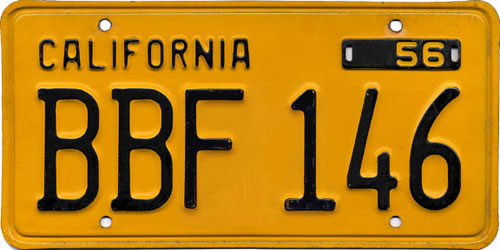
I grew up in California and saw many, many license plates on cars, starting
long before I could drive. In 1990, at age 24-25, I began noting down my
observations about the colors, designs, characters, and standard patterns
on California's license plates in a very short file called PLATES.LIC. You can
get a good idea of when a car was made — or at least, when it was
registered with the California DMV — by its license plate.
The webpage you're reading now contains descriptions of California license plates throughout history, as observed through the years by Roger M. Wilcox.
Prior to 1942, a new license plate was issued to every vehicle registered in California annually. World War II, however, meant that the metal from which to make the license plates became scarce. Starting in 1942, vehicles that already had a license plate were instead issued small metal overlays (called validation tabs) with only the last 2 digits of the year stamped onto them. These were shaped to match the portion of the plate where the last 2 digits of the original (issuing) year were shown; the recipient was supposed to place it directly over the old year. In 1944, metal became scarce enough that the first validation stickers were issued — a practice that would not be seen again until the standardized yellow plate era (1956-1962).
Nearly all of these plates were all made out of steel. However, during WW2 steel was in short supply and at some point California opted to instead make its plates out of aluminum for the first time. The practice reverted to using steel after the second world war ended, but was briefly resumed during the Korean war. (Source: VR-Manual-Appendix-1E-accessible-5-2022.pdf, retrieved from https://www.dmv.ca.gov/portal/file/vr-manual-appendix-1e on 27-June-2025)
New license plate designs appeared every few years thereafter, until an internationally standardized shape and size appeared in 1956. Presumably, since these 1945-1955 plate designs all had the year in a different place, an entire new plate had to be issued to a vehicle every time the plate designed changed. (Otherwise, the new validation tabs wouldn't properly cover up the old year.)

The 1956 plates had raised (embossed) black text on a yellow background. Rectangular holes on either side of the "56" were put there to allow metal validation tabs to be placed over the year. However, validation tabs were never issued. Instead, from 1957 through 1962, validation stickers with all 4 digits of the year written on them were to be placed next to the "56" on the plate.
License plates issued during this era had raised yellow text on a black background. "CALIFORNIA" was in smaller raised yellow text at the top, in characters that looked like block printing. The letters were wider than the numeric digits, leaving enough room for a total of 6 characters plus one half-space.
Nearly all of these plates were made of steel. If you press a refrigerator magnet up against one of them, it will stick to it. In their last year of issue (1969) a few of the final black plates made were composed of aluminum.
In 1963, all vehicles that had the previous yellow plates were issued a new black plate. New vehicles were also, of course, issued these black plates. Black plates had the number "63" stamped into the well on the upper-right. (This stamp was merely a pair of dents in the shape of the digits 6 and 3. There was no paint to make them stand out.) This "63" persisted late into the Black Plate era, but by the end some plates issued had no stamp in the upper-right well. Some have speculated that this may have happened because the "63" on the plate-stamping dies had gotten worn down from use. The first year validation sticker was required to be placed in the upper-right well, over the stamped "63". Subsequent year's validation stickers were supposed to alternate between being placed in the upper-left well and the upper-right well.
The letter Q on early black plates appeared with a tiny serif. From a distance, or if there was any dirt or damage on the plate, these small-serif Q's were difficult to distinguish from an O. This was eventually corrected by changing the Q to have a big, swooshy serif some time in the middle of the black plate era.
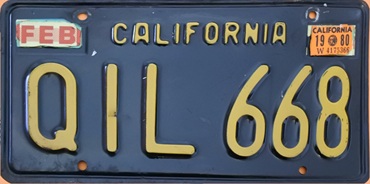
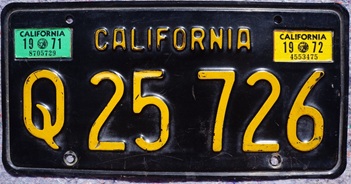
The letter I was a simple vertical line with no serifs. From a distance, if a reader wasn't paying close attention, it could be confused with the numeric digit 1, since the early plates used a 1 digit that also lacked a bottom serif. Later plates added a serif to the bottom of the 1.
Starndard plates issued for passenger cars during this era had license numbers that consisted of 3 letters, followed by a half-space, followed by 3 numeric digits. The first such plate issued would have been AAA 000. The digits were incremented first, then they wrapped back around to zeroes and the letters were incremented, i.e. the plates would've gone AAA 000, AAA 001, AAA 002, ..., AAA 999, then AAB 000, AAB 001, etc..
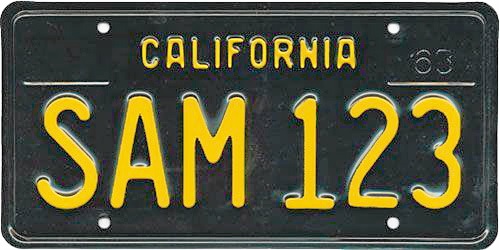
Nominally, this would've yielded 263 times 103, or 17 576 000 possible combinations. However, not all combinations were used. Due to the potential for confusion between the letter I and the number 1, and between the letters O and Q and the number 0, the 3-letter portion of the license number couldn't end with an I, O, or Q. (Unlike the modern era, such license numbers could begin with an I, O, or Q, however.)
Becase all passenger cars were issued a black plate in 1963, this year saw an enormous number of license number combinations being used. Many cars that had been registered in previous years were issued license numbers that ran deep into the alphabet. For example, the author of this page once owned a 1959 Edsel which had doubtlessly been registered in California when it was bought new, yet whose black license plate had the "63" stamp in the upper right corner and read DOU 526.
The transition from black plates to blue plates coincided with the exhaustion of passenger plate license number combinations.
Standard plates issued for commercial vehicles during this era had license numbers that consisted of one letter, followed by a half-space, followed by 2 numeric digits, followed by another half-space, followed by 3 numeric digits. The first such plate issued would have been A 00 000. As with passenger plates, the digits were incremented first, going right-to-left, and when they wrapped around the letter was incremented, i.e. the plates would've gone A 00 000, A 00 001, A 00 002, ..., A 99 999, then B 00 000, B 00 001, etc..
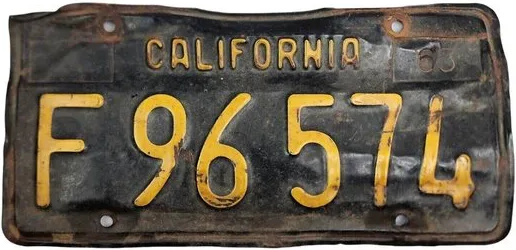
This would yield a maximum of 26 times 105, or 2 600 000 possible combinations, approximately 15% as many possible combinations as there were for passenger plates. I'm guessing that, as with passenger plates, the letter could not be an I or an O due to its potential for confusion with a 1 or a 0, but I have no observations to back that up.
This limited number of combinations actually presented a problem. California could have chosen to use the 2-letters-and-4-digits pattern for commercial plates, which would have resulted in 6 760 000 possible combinations. But California instead chose to use that pattern for trailer plates (as discussed below). My guess is that California probably thought that, because one truck could be used to tow several trailers, there would be more trailers registered in California than there were commercial vehicles. The problem is, California also required all smaller vehicles that typically had commercial uses to get a commercial plate, even if the vehicle wasn't actually intended for commercial use.
Including pickup trucks.
With the explosion in the popularity of pickup trucks as ordinary commuter vehicles, in the 6 years of the black plate era there were far more vehicles registered in California that required commercial plates than there were commercial plate license number combinations available. They ran out of license numbers before this short era was even over.
To stretch the supply of available license number combinations, the order of the characters was subsequently reversed. Rather than a letter followed by 5 digits, the later black commercial plates had 5 digits followed by a letter. As before, the digits were incremented first, followed by incrementing the letter once 99 999 wrapped around to 00 000.
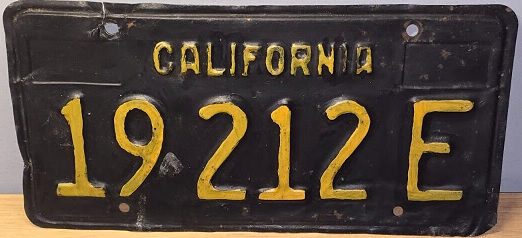
Starndard plates issued for trailers during this era had license numbers that consisted of two letters, followed by a half-space, followed by 4 numeric digits. The first such plate issued would have been AA 0000. As with passenger and commercial plates, the digits were incremented first, then when they wrapped back around to zero the letters were incremented, i.e. the plates would have gone AA 0000, AA 0001, AA 0002, ..., AA 9999, then AB 0000, AB 0001, etc..
This would yield a maximum of 262 times 105, or 6 760 000 possible combinations. I'm guessing that, as with passenger plates, the last letter could not be an I, O, or Q due to its potential for confusion with a 1 or a 0, but I have no observations to back that up.
Unlike commercial plates, there were far more possible license number combinations available for trailers than there were trailers registered in California. Perhaps they underestimated the number of trucking companies that would choose to register their trailers in states with lower vehicle taxes.
According to online sources, license numbers starting with UA through YX were reserved for commercial weight fee trailiers (trailers bigger than a certain threshold, which are required to pay a weight fee as part of their registration cost).
License plates issued during this era had raised yellow text on a blue background. "CALIFORNIA" was in smaller raised yellow text at the top, in characters that looked like block printing. At first, the letters were wider than the numeric digits, leaving enough room for a total of 6 characters plus one half-space.
At the beginning of this era, some of these plates were made of steel and others were made of aluminum. You can tell whether a given plate is steel or aluminum by holding a magnet up to it. The steel plates are also subject to rusting. Later, all plates were made out of aluminum, a practice which continues to this day. According to California DMV records, 1972 was the last year steel license plates were made, bun one source claims to have steel plates issued in 1975.
It was in the middle of this era (1976) that California began issuing month stickers. These stickers were initially red-on-white, but were changed to blue-on-white in 1986.
By the middle of the 1970s, the number of vehicles registered in Califonia had become so enormous that it was clear the available 6-character license number combinations would soon run out. California had, and still has, a strict policy of never re-issuing the same license number to a different vehicle unless the original vehicle's owner pays for a "plate transfer." Even if the original vehicle had been sent to the junkyard years ago, its license number would never be reused. So when the combinations ran out, California became the first U.S. state to issue license plates with enough room for 7 characters plus one half-space. They accomplished this by narrowing the letters, but keeping the numeric digits the same width.
When the letters were first narrowed, the middle crossbar on the E and F was short and stubby. These were changed to a long middle crossbar (almost, but not quite, as long as the top horizontal line on the letter) some time later.
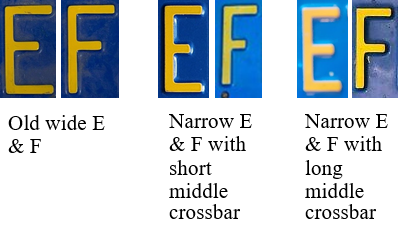
As with black plates, the letter I on early blue plates was still just a simple vertical line with no serifs. The serifs on the 1 did distinguish it from the letter I, but there was still a risk of confusing the two. As a result, some time in the 1970s — after the switchover to 7-character plates — serifs were added to the top and bottom of the letter I.
Starndard plates issued for passenger cars during the early-to-mid part of this era had license numbers that consisted of 3 numeric digits, followed by a half-space, followed by 3 letters. This was the reverse of the combination used on the older black plates. The first such plate issued would have been 000 AAA. The digits were incremented first, then when they wrapped back around to zeroes the letters were incremented, i.e. the plates would've gone 000 AAA, 001 AAA, 002 AAA, ..., 999 AAA, then 000 AAB, 001 AAB, etc..
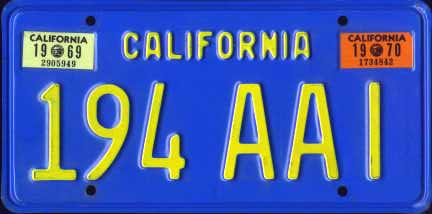
Image from
http://www.15q.net/ca.html
Due to the potential for confusion between the letter I and the number 1, and between the letters O and Q and the number 0, the 3-letter portion of the license number couldn't begin with an I, O, or Q. (Unlike the modern era, such license numbers could end with an I, O, or Q, however.)
Late in the 1970s, these combinations ran out. (By that time, the letters had already gotten narrower, allowing a smooth transition to 7-character license numbers.) From that point onward, the standard plates issued for passenger cars had license numbers consisting of the numeric digit 1, followed by 3 letters, followed by 3 numeric digits. No half-space was used between any of these characters, even though sufficient room for a half-space did exist on the plate. The first such plate issued would have been 1AAA000. As with the earlier combination, the digits were incremented first, then when they wrapped back around to zeroes the letters were incremented, i.e. the plates would've gone 1AAA000, 1AAA001, 1AAA002, ..., 1AAA999, then 1AAB000, 1AAB001, etc..
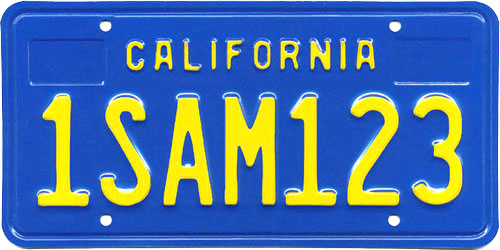
Image from
https://japanesenostalgiccar.com/true-history-of-period-correct-california-license-plates/
The 3-letter portion of these 7-character license plate numbers could neither begin, nor end, with an I, O, or Q.
In the early part of this era, standard plates issued for commercial vehicles continued the pattern in force at the end of the black plate era. That is, license numbers consisted of 2 numeric digits, followed by a half-space, followed by 3 numeric digits, followed by another half-space, followed by a letter. The digits were incremented first, going right-to-left, and when they wrapped around the letter was incremented, i.e. in the middle of the run the plates would've gone 00 000 M, 00 001 M, 00 002 M, ..., 99 999 M, then 00 000 N, 00 001 N, etc..
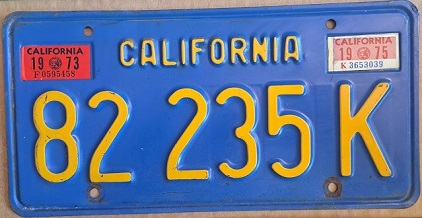
By the mid-1970s, these combinations ran out. In fact, they ran out before the 6-character passenger plate combinations ran out, probably due to the popularity of pickup trucks. This moment probably coincided with the narrowing of the letters on blue plates. From that point onward, license numbers for commercial vehicles consisted of a single numeric digit, followed by a single letter, followed by 5 numeric digits, with no half-spaces between any of these characters. The 5-digit group was incremented first, then when it wrapped around to zero the letter was incremented, then when the letter wrapped back around to A the first digit was incremented, i.e. the plates would've gone 1A00000, 1A00001, 1A00002, ..., 1A99999, 1B00000, 1B00001, ..., 1Z99998, 1Z99999, 2A00000, 2A00001, etc..
Starndard plates issued for trailers during this era had license numbers that continued the pattern that had been in force throughout the black plate era. That is, two letters, followed by a half-space, followed by 4 numeric digits.
According to online sources, license numbers starting with UA through YX were issued to commercial weight fee trailiers (trailers bigger than a certain threshold, which are required to pay a weight fee as part of their registration cost).
The transition from wide letters to narrow letters happened some time along the way.
This was issued as an optional design. Until early 1987, a person registering a new vehicle in California would still, by default, get a normal blue license plate (with the normal yellow lettering). However, if he or she paid an addition 5 dollar fee, the vehicle would be issued a special, artistically-rendered plate design. Many to this day still consider this to be California's best license plate.
License plates issued during this era had raised dark-blue text on a white background. The stylized "CALIFORNIA" across the top was a work of art, with the O in the middle of the word made to look like the setting sun against the horizon of the pacific ocean. The words "The Golden State" appeared at the bottom of the plate, in small yellowish letters placed low enough that they'd be obscured by a license plate frame — for this reason, these plates are officially called "Golden State" plates.
Letters and numeric digits in the license number were both narrow, the same sizes and shapes as the letters and numbers used at the end of the blue plate era. There was enough room for a total of 7 characters plus one half-space. As with the blue plates, the middle crossbar on the E and F was initially short and stubby, and was changed to a long middle crossbar early on in the era (probably at the same time they changed in the blue plates).
During this era, blue plates continued to be issued alongside the California sunset plates. Blue passenger plates continued to use license numbers with patterns of the form 1___###, where each _ was a letter and each # was a numeric digit. To avoid overlapping with these combinations, California sunset passenger plates all started with a 2.
Starndard California sunset plates issued for passenger cars had license numbers that consisted of the numeric digit 2, followed by 3 letters, followed by 3 numeric digits. No half-space was used between any of these characters. The first such plate issued would have been 2AAA000. As before, the 3 digit group was incremented first, then when they wrapped back around to zeroes the letters were incremented, i.e. the plates would've gone 2AAA000, 2AAA001, 2AAA002, ..., 2AAA999, then 2AAB000, 2AAB001, etc..
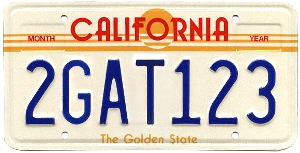
Image from
https://japanesenostalgiccar.com/true-history-of-period-correct-california-license-plates/
Blue commercial plates continued to use license numbers with patterns of the form 2_#####. To avoid overlapping with these combinations, California sunset commercial plates all started with a 3.
Starndard California sunset plates issued for commercial vehicles had license numbers that consisted of the numeric digit 3, followed by a single letter, followed by 5 numeric digits. No half-space was used between any of these characters. The first such plate issued would have been 3A00000. As before, the 3 digit group was incremented first, then when they wrapped back around to zeroes the letter was incremented, i.e. the plates would've gone 3A00000, 3A00001, 3A00002, ..., 3A99999, then 3B00000, 3B00001, etc..
Blue trailer plates continued to use license numbers with patterns of the form __ ####. To avoid overlapping with these combinations, California sunset trailer plates all added a 1 to the beginning, and (as with the other 7-character combinations) removed the half space. The first such plate issued would have been 1AA0000. As before, the 4 digit group was incremented first, then when they wrapped back around to zeroes the letters were incremented, i.e. the plates would've gone 1AA0000, 1AA0001, 1AA0002, ..., 1AA9999, then 1AB0000, 1AB0001, etc..
Similar to the black and blue trailer plates, California sunset trailer plates issued for commercial weight fee trailers started with 1UA0000, continuing onward. This pattern has continued on later plate designs to this day. The pattern is required to end at 1YX8000.
In the 1980s, it became practical to make license plates coated in retroreflective microbeads. Retroreflection made a license plate much easier to read at night. To accomplish this feat, the background color of the plate had to be pure white, and the lettering had to be a darker non-retroreflective color in the shape of the letters or numbers you wanted to be readable at night. At the end of 1987, California state law made it mandatory for all license plates issued to have a retroreflective coating.
While the California sunset design did have a white background (or something close to white, at least), the law required not only the license number, but also the name of the state, to be readable at night under retroreflection. The California sunset logo, with its light-brown striping and sun, didn't allow the name of the state to be read at night, no matter how innovative the artists were with their placement of the retroreflective coating. So instead, California returned to the older "CALIFORNIA" stamped in raised letters that had been used during the black and blue license plate eras, except colored red instead of blue or yellow. The letters and numeric digits of the license number remained the same blue used for the California sunset plates. The words "The Golden State" did not appear at the bottom of the plate, like they did for the California sunset plate.
This change also resulted in a cost savings of four whole cents per license plate.
Starndard white-with-California-in-block-printing plates issued for passenger cars had license numbers that continued the pattern in use by the California sunset plates. That is, they consisted of a single numeric digit (starting with 2), followed by 3 letters, followed by 3 numeric digits. No half-space was used between any of these characters. As before, the 3 digit group was incremented first, then when they wrapped back around to zeroes the letters were incremented, then when the letters wrapped back around to A's the first numeric digit was incremented.
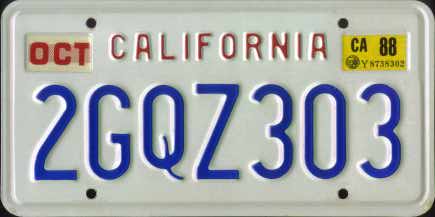
Image from
http://www.15q.net/ca.html
Starndard white-with-California-in-block-printing plates issued for commercial vehicles continued the license plate number pattern that had been in use by the California sunset plates. That is, they consisted of a single numeric digit, followed by a single letter, followed by 5 numeric digits. No half-space was used between any of these characters. As before, the 3 digit group was incremented first, then when they wrapped back around to zeroes the letter was incremented, then when the letter wrapped back around to A the first digit was incremented.
White-with-California-in-block-printing trailer plates continued to follow the pattern of the California sunset trailer plates, with a single numeric digit followed by two letters followed by four numeric digits.
Starting in the 1990s, "California" started being written in a trendy red script across the top of the license plate, instead of being stamped in raised block lettering. This practice has continued to this day.
At various points, different text appeared in red at the bottoms of these plates. From 1998-2000, this text read "SESQUICENTENNIAL - 150 YEARS". Starting in 2011, the text began to read "dmv.ca.gov".
Standard white-with-California-in-cursive-handwriting passenger plates continued to follow the same license numbering pattern as the previous white-with-California-in-block-printing passenger plates had. That is, a numeric digit, followed by three letters, followed by three numeric digits.

Starndard white-with-California-in-cursive-handwriting plates issued for commercial vehicles continued the license plate number pattern that had been in use by the white-with-California-in-block-printing plates. That is, they consisted of a single numeric digit, followed by a single letter, followed by 5 numeric digits. No half-space was used between any of these characters. As before, the 3 digit group was incremented first, then when they wrapped back around to zeroes the letter was incremented, then when the letter wrapped back around to A the first digit was incremented.
Eventually, in either the late 2010s or the early 2020s, these combinations ran out. When this happened, the order was reversed: 5 numeric digits, followed by a single letter, followed by a single numeric digit. This pattern would have gone 00000A1, 00001A1, 00002A1, ..., 99999A1, 00000B1, 00001B1, ..., 99999Z1, 00000A2, 00001A2, etc..
White-with-California-in-cursive-handwriting trailer plates continued to follow the pattern of the white-with-California-in-block-printing trailer plates, with a single numeric digit followed by two letters followed by four numeric digits.
Prior to 2001, all trailers had to get a new registration sticker every year, just like cars and trucks did. Starting in 2001, trailers began instead to be issued "permanent trailer identification". A $10 registration renewal fee still had to be paid every 5 years, but this was so small that it wasn't worth it to require evidence to be displayed on the trailer itself. It is not clear whether these plates are also used for commercial weight fee trailers, but one online source implies that they're used for Apportioned trailer plates, i.e. plates on trailers whose registration fees are split between California and another state, whether the trailer requires a weight fee or not. (On 30-June-2025, I saw a big-rig trailer with a permanent trailer plate, whose license number was 4SW5425.)

Trailers with existing plates were issued a white "PTI" sticker, which was to cover up the previous year's annual registration sticker. Newly registered trailers were issued white plates with the "California" logo replaced with the words "California Perm Trailer" (also in trendy script), and red bars replacing the month/year registration sticker wells in the upper corners.
While the license numbers on these plates did continue the digit/letter/four-digits pattern of previous trailer plates, the first digit started with 4 to avoid overlapping the combinations used on previous plates.
Send comments about this webpage to: rogermw@ix.netcom.com.
Go back to Roger M. Wilcox's home page.